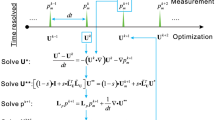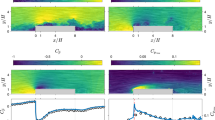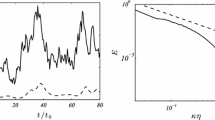Abstract
The three-dimensional spatial filtering and measurement noise associated with experimental planar and three-dimensional (3D) particle image velocimetry (PIV) measurements is investigated using a combination of direct numerical simulations (DNS) and experimental databases. Spatial filtering velocity fields from a DNS of a zero-pressure-gradient turbulent boundary layer (TBL) at resolutions typical of PIV experiments are shown to underestimate Reynolds stresses by as much as 50 %. Comparison of experimental PIV measurement of a turbulent channel flow and 3D tomographic PIV measurements of a TBL with higher-resolution simulations and hot-wire anemometry measurements show that in real experiments, measurement noise acts to offset this effect. This is shown to produce measurements that appear to provide a good estimate of the turbulent fluctuations in the flow, when in reality the flow is spatially under-resolved and partially contaminated by noise. Means of identifying this noise are demonstrated using the one-dimensional (1D) velocity power spectra and the 1D transfer function between the power spectra of the unfiltered velocity field and the power spectra calculated from the filtered experimental measurement. This 1D transfer function differs from the commonly used sinc transfer function of PIV owing to the integrated effect of filtering in multiple directions. Failure to incorporate this difference is shown to overestimate the maximum resolved wave number in the 3D spectra of the planar PIV by close to 10 %, while conversely underestimating the maximum resolved wave number in the 3D PIV by 50 %. Appropriate spatial filtering of the experimental data is shown to remove the noise-dominated small-scale fluctuations and bring the data inline with that which should be obtained for a noiseless PIV measurement at the corresponding spatial resolution.

















Similar content being viewed by others
References
Adrian RJ, Westerweel J (2011) Particle image velocimetry. Cambridge Aerospace Series, Cambridge University Press, New York
Adrian RJ, Meinhart CD, Tomkins CD (2000) Vortex organization in the outer region of the turbulent boundary layer. J Fluid Mech 422:1–54
Amili O, Soria J (2011) A film-based wall shear stress sensor for wall-bounded turbulent flows. Exp Fluids 51:137–147. doi:10.1007/s00348-010-1035-5
Atkinson C (2012) An experimental technique for the investigation of the three-dimensional structure of wall-bounded turbulence. Ph.D. Thesis, Monash University and Ecole Centrale de Lille
Atkinson C, Soria J (2009) An efficient simultaneous reconstruction technique for tomographic particle image velocimetry. Exp Fluids 47(4):553–568
Atkinson C, Coudert S, Foucaut JM, Stanislas M, Soria J (2011) The accuracy of tomographic particle image velocimetry for measurements of a turbulent boundary layer. Exp Fluids 50:1031–1056. doi:10.1007/s00348-010-1004-z
Carlier J, Stanislas M (2005) Experimental study of eddy structures in a turbulent boundary layer using particle image velocimetry. J Fluid Mech 535:143–188
Dennis DJC, Nickels TB (2011) Experimental measurement of large-scale three-dimensional structures in a turbulent boundary layer. Part 2. Long structures. J Fluid Mech 673:218–244
Elsinga GE, Scarano F, Wieneke B, van Oudheusden BW (2006) Tomographic particle image velocimetry. Exp Fluids 41:933–947
Foucaut JM, Stanislas M (2002) Some considerations on the accuracy and frequency response of some derivative filters applied to particle image velocimetry vector fields. Meas Sci Technol 13:1058–1071
Foucaut JM, Milliat B, Perenne N, Stanislas M (2003) Characterisation of different PIV algorithms using the europiv synthetic image generator and real images from a turbulent boundary layer. In: Particle image velocimetry: recent improvements; Proceedings of the EUROPIV2 workshop, Zaragoza, Spain
Foucaut JM, Carlier J, Stanislas M (2004) PIV optimization for the study of turbulent flow using spectral analysis. Meas Sci Technol 15:1046–1058
Fouras A, Soria J (1998) Accuracy of out-of-plane vorticity measurements derived from in-plane velocity field data. Exp Fluids 25:409–430
Ganapathisubramani B, Hutchins N, Hambleton WT, Longmire EK, Marusic I (2005) Investigation of large-scale coherence in a turbulent boundary layer using two-point correlations. J Fluid Mech 524:57–80
Hearst RJ, Buxton ORH, Ganapathisubramani B, Lavoie P (2012) Experimental estimation of fluctuating velocity and scalar gradients in turbulence. Exp Fluids 53(4):925–942. doi:10.1007/s00348-012-1318-0
Herpin S, Wong CY, Stanislas M, Soria J (2008) Stereoscopic PIV measurements of a turbulent boundary layer with a large spatial dynamic range. Exp Fluids 45(4):745–763
Hoyas S, Jiménez J (2006) Scaling of the velocity fluctuations in turbulent channels up to Re τ = 2003. Phys Fluids 18:011702
Huang H, Dabiri D, Gharib M (1997) On errors of digital particle image velocimetry. Meas Sci Technol 8:1427–1440
Huang HT, Fiedler HE, Wang JJ (1993) Limitations and improvements of PIV; part II: particle image distortion, a novel technique. Exp Fluids 15:263–273
Kähler CJ (2004) Investigation of the spatio-temporal flow structure in the buffer region of a turbulent boundary layer by means of multiplane stereo PIV. Exp Fluids 36:114–130
Lavoie P, Avallone G, De Gregorio F, Romano GP, Antonia RA (2007) Spatial resolution of PIV for the measurement of turbulence. Exp Fluids 43:39–51
Lourenco L, Krothapalli A (2000) True resolution PIV, a mesh free second order accurate algorithm. In: Proceedings of 10th international symposium on on applications of laser techniques in fluid mechanics, Lisbon, Portugal
Oxlade AR, Valente PC, Ganapathisubramani B, Morrison JF (2012) Denoising of time-resolved PIV for accurate measurement of turbulence spectra and reduced error in derivatives. Exp Fluids 53:1561–1575. doi:10.1007/s00348-012-1375-4
Perry AE, Henbest S, Chong MS (1986) A theoretical and experimental study of wall turbulence. J Fluid Mech 165:163-199
Prasad AK, Adrian RJ (1993) Stereoscopic particle image velocimetry applied to liquid flows. Exp Fluids 15:49–60
Raffel M, Willert C, Kompenhans J (1998) Particle image velocimetry: a practical guide. Springer, New York
Saikrishnan N, Marusic I, Longmire EK (2006) Assessment of dual plane PIV measurements in wall turbulence using DNS data. Exp Fluids 41:265–278
Scarano F (2002) Iterative image deformation methods in PIV. Meas Sci Technol 13:R1–R19
Schröder A, Geisler R, Elsinga GE, Scarano F, Dierksheide U (2008) Investigation of a turbulent spot and a tripped turbulent boundary layer flow using time-resolved tomographic PIV. Exp Fluids 44:305–316
Soria J (1996) An investigation of the near wake of a circular cylinder using a video-based digital cross-correlation particle image velocimetry technique. Exp Therm Fluid Sci 12:221233
Soria J (2006) Particle image velocimetry: applications to turbulence studies. In: Shats M, Punzmann H (eds) Lecture notes on turbulence and coherent structures in fluids, plasmas and nonlinear medium, World Scientific lecture notes in complex systems, vol 4., World Scientific Publishing, Singapore, pp 309–347
Soria J (2008) Effect of velocity gradients on 3D cross-correlation PIV analysis. Lisbon, Portugal, pp 1–11
Tanaka T, Eaton JK (2007) A correction methods for measuring turbulence kinetic energy dissipation rate by PIV. Exp Fluids 42:893–902. doi:10.1007/s00348-007-0298-y
Vétel J, Garon A, Pelletier D (2011) Denoising methods for time-resolved PIV measurements. Exp Fluids 51(4):893–916. doi:10.1007/s00348-011-1096-0
Willert CE, Gharib M (1991) Digital particle image velocimetry. Exp Fluids 10:181–193
Wu X, Moin P (2010) Transitional and turbulent boundary layer with heat transfer. Phys Fluids 22:085105
Acknowledgments
The support of Australian Research Council for this work is gratefully acknowledged. TPIV experiments were perform in collaboration with the researchers at the Laboratoire de Mécanique de Lille, during which time C.A. was supported by an Eiffel Fellowship and an Australian Postgraduate Award. Our thanks to Associate Professor Xiaohua Wu for graciously providing the DNS velocity fields that were used in this study.
Author information
Authors and Affiliations
Corresponding author
Rights and permissions
About this article
Cite this article
Atkinson, C., Buchmann, N.A., Amili, O. et al. On the appropriate filtering of PIV measurements of turbulent shear flows. Exp Fluids 55, 1654 (2014). https://doi.org/10.1007/s00348-013-1654-8
Received:
Revised:
Accepted:
Published:
DOI: https://doi.org/10.1007/s00348-013-1654-8




